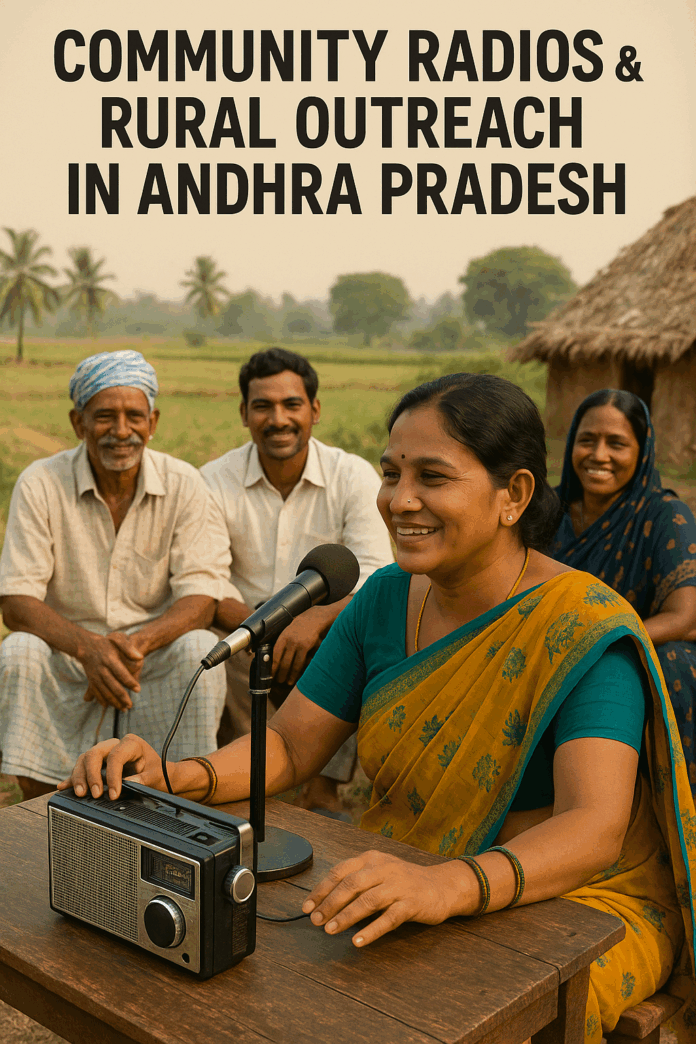📡 Community Radios and Rural Outreach in Andhra Pradesh
In the vast and culturally diverse state of Andhra Pradesh, where connectivity gaps still exist in remote and tribal regions, community radio stations have emerged as powerful tools for empowerment and inclusion. Operating in local dialects and catering to specific regional needs, these grassroots media platforms are playing a transformative role in delivering information, amplifying local voices, and promoting sustainable development.
🎙️ What Are Community Radios?
Community radios are small, non-profit, locally operated radio stations that serve a specific community. Unlike commercial or public broadcasters, these radios focus on local issues, voices, and needs. In Andhra Pradesh, they’ve become crucial mediums in rural and semi-urban areas where mainstream media coverage is either minimal or absent.
🌾 Serving the Underserved: Fishermen, Tribals & Farmers
One of the biggest strengths of community radios in Andhra Pradesh lies in their ability to serve hyperlocal communities, including:
1. Fisherfolk on the Coast
- Andhra Pradesh has a vast coastline, and fishing communities often lack real-time access to crucial information.
- Community radios broadcast weather alerts, cyclone warnings, fishing bans, and sea condition updates in Telugu and local coastal dialects, ensuring safety and preparedness.
- Awareness programs on marine laws, sustainable fishing, and government schemes are also aired.
2. Tribal Populations in Agency Areas
- In districts like Visakhapatnam and Alluri Sitharama Raju, tribal communities have limited access to the internet or television.
- Community radios help preserve tribal languages and cultures while broadcasting health tips, rights awareness, agriculture practices, and local governance updates in regional idioms.
- This localized communication fosters inclusion and education without the barrier of formal literacy.
3. Farmers in Remote Villages
- For many farmers, community radio is a daily source of guidance.
- Topics include crop disease prevention, weather forecasts, organic farming techniques, and information on market prices.
- The interactive format—where farmers can call in and ask questions or share problems—makes the medium participatory and solution-oriented.
🗣️ Inclusion Through Regional Dialects
Unlike national or urban-centric media, community radios embrace regional accents, dialects, and cultures. In Andhra Pradesh, this includes variations of Telugu, tribal languages like Kui, Savara, Konda, and other rural tongues. This linguistic inclusiveness:
- Makes information more relatable and trustworthy
- Encourages local storytelling, folk music, and oral traditions
- Boosts participation from women and youth, who might feel alienated by mainstream content
📡 Notable Community Radio Stations in Andhra Pradesh
Some of the prominent initiatives include:
- Mana Radio (Krishna district): Focuses on education, environment, and health for rural communities.
- Radio Vishnu (West Godavari): Run by a college, offering programs on social welfare, agriculture, and youth leadership.
- Deccan Radio (Hyderabad, bordering AP): Earlier helped connect urban slums and nearby regions.
Each station operates on a limited radius (usually 10–15 km) but has a deep impact within that zone.
💡 Empowering Communities with Real-Time, Relevant Information
During crises like COVID-19 lockdowns, community radios played a vital role in spreading health protocols, dispelling myths, and guiding people on vaccination drives and welfare schemes. They act as:
- Bridges between local governments and citizens
- First responders during emergencies
- Platforms for civic participation, especially for marginalized voices
🛠️ Challenges Faced
Despite their impact, community radio stations in Andhra Pradesh face:
- Limited funding and reliance on donations or grants
- Shortage of trained personnel
- Licensing delays and regulatory red tape
- Poor infrastructure, especially in hilly or forested areas
🤝 How Bharat Media Association (BMA) Supports Community Radios
BMA recognizes the powerful role community radios play in journalism and rural development. Here’s how BMA contributes:
- Training and capacity building for community radio reporters in ethical journalism and technical skills
- Legal assistance in acquiring broadcast licenses or resolving disputes
- Recognition and awards for outstanding rural reporting
- Grants and sponsorship networking to sustain operations
- A central repository of rural data and best practices, accessible to all affiliated stations
BMA’s goal is to bridge the urban-rural information divide and empower grassroots journalists to tell the untold stories of their regions.
📌 Conclusion
In a state as diverse as Andhra Pradesh, community radios are not just media they are lifelines. They give voice to the voiceless, celebrate local cultures, and empower communities with the knowledge they need to thrive. With the support of platforms like Bharat Media Association, community radios can scale their impact, reach more regions, and become even stronger agents of positive change.









